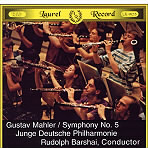This is an amazing performance. I have no hesitation in recommending it as one of the half dozen or so best recordings of the work currently available, right up there with Bernstein (DG), Karajan (DG), Barbirolli (EMI), and Tennstedt (NY Philharmonic Special Editions), and that goes for both the interpretation and the playing. When you consider, further, that this concert performance is an all-or-nothing, one take effort, then admiration for the achievement of Rudolf Barshai and his band of German high school students turns to awe. They yield to no one in tonal richness, just intonation, rhythmic accuracy, or stylishness of execution, and their response to Mahler’s music is totally idiomatic. Check out the passage immediately preceding the triumphant brass chorale in the second movement: trombones descend to the depths, and through a haze of tam-tam resonance the strings play with a dark richness that defies description. This classic “Mahler moment” has never been better realized on disc. Solo players–trumpet, oboe, clarinet, and especially the extraordinary principal horn–have nothing to fear in comparison to their professional counterparts on the recordings listed above. They are, one and all, superb.
The Fifth is Mahler’s most difficult symphony to play well, particularly for the strings, a result of its relentlessly contrapuntal textures. When you consider that the work consists, after the opening funeral march, of a violently turbulent second movement, the world’s longest symphonic scherzo, a slow movement for strings alone (with harp), and then a lengthy, fugal finale during all of which the strings are constantly engaged either with solo lines or busy, contrapuntal accompaniments, it’s apparent just how challenging this music is. Suffice it to say that these kids offer some of the finest string playing this piece has ever received on disc. It has weight as well as genuine, passionate intensity. Just listen to the cellos and basses attack the opening of the second movement! The way these five sections dig into those fugatos in the scherzo and finale, their gentle elegance in the Adagietto–well, it simply disarms criticism.
Of course, much of the credit belongs to Barshai, an incredibly gifted orchestral trainer and, on evidence here, a major Mahler interpreter. The timings reveal much–11:53; 14:26; 18:29; 8:17; 16:18. These last three are especially noteworthy. Barshai leads one of the slowest scherzos on disc, but one full of the lilt of the dance, and moreover a performance so intelligently integrated and focused on the long line that it plays like one of the quicker versions. The Adagietto flows (correctly) at Bruno Walter’s tempo, sounding so much more effective at a speed that makes clearly audible the tension between the actual time signature, the syncopated principal melodic material, and Mahler’s across-the-bar-line harmonic suspensions. The finale, while also moderately paced, has such contrapuntal clarity that speed becomes irrelevant: it has a much more important quality, that of physical movement. It’s exactly the performance that, say, Otto Klemperer would have given in his prime: tough, gritty, unsentimental, uncompromisingly truthful, and ultimately triumphant. All of this is captured in natural, minimally miked sound, not ideally clear perhaps, but again far better than numerous studio jobs.
I realize that some readers might raise an eyebrow or two on reading a rave about a performance by a student orchestra under a conductor not usually identified with this repertoire. I’ve listened to this recording, in whole or in part, nearly a dozen times now, and shared it with several of my most respected colleagues. We all agree that this performance is something very special. Hearing’s believing.
































